Jason Ramapuram
Distillation Scaling Laws
Feb 12, 2025Abstract:We provide a distillation scaling law that estimates distilled model performance based on a compute budget and its allocation between the student and teacher. Our findings reduce the risks associated with using distillation at scale; compute allocation for both the teacher and student models can now be done to maximize student performance. We provide compute optimal distillation recipes for when 1) a teacher exists, or 2) a teacher needs training. If many students are to be distilled, or a teacher already exists, distillation outperforms supervised pretraining until a compute level which grows predictably with student size. If one student is to be distilled and a teacher also needs training, supervised learning should be done instead. Additionally, we provide insights across our large scale study of distillation, which increase our understanding of distillation and inform experimental design.
Theory, Analysis, and Best Practices for Sigmoid Self-Attention
Sep 06, 2024



Abstract:Attention is a key part of the transformer architecture. It is a sequence-to-sequence mapping that transforms each sequence element into a weighted sum of values. The weights are typically obtained as the softmax of dot products between keys and queries. Recent work has explored alternatives to softmax attention in transformers, such as ReLU and sigmoid activations. In this work, we revisit sigmoid attention and conduct an in-depth theoretical and empirical analysis. Theoretically, we prove that transformers with sigmoid attention are universal function approximators and benefit from improved regularity compared to softmax attention. Through detailed empirical analysis, we identify stabilization of large initial attention norms during the early stages of training as a crucial factor for the successful training of models with sigmoid attention, outperforming prior attempts. We also introduce FLASHSIGMOID, a hardware-aware and memory-efficient implementation of sigmoid attention yielding a 17% inference kernel speed-up over FLASHATTENTION2 on H100 GPUs. Experiments across language, vision, and speech show that properly normalized sigmoid attention matches the strong performance of softmax attention on a wide range of domains and scales, which previous attempts at sigmoid attention were unable to fully achieve. Our work unifies prior art and establishes best practices for sigmoid attention as a drop-in softmax replacement in transformers.
Poly-View Contrastive Learning
Mar 08, 2024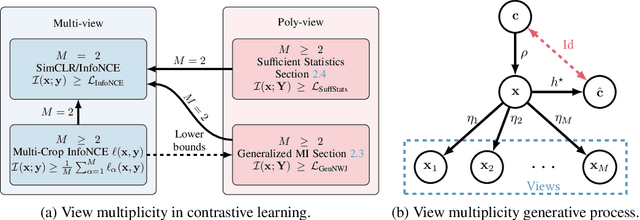
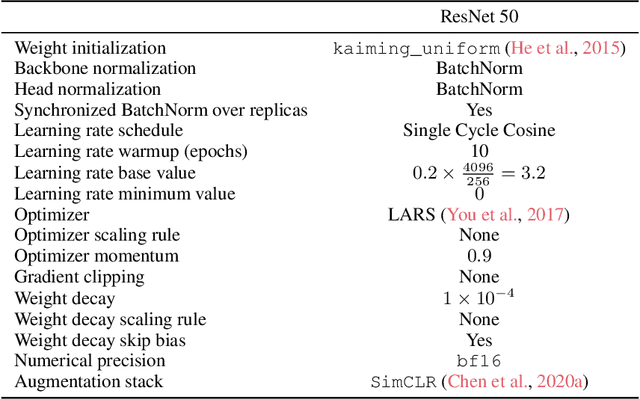

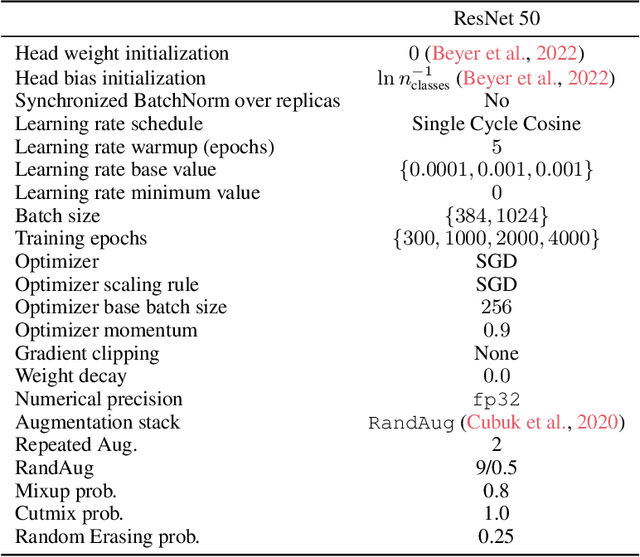
Abstract:Contrastive learning typically matches pairs of related views among a number of unrelated negative views. Views can be generated (e.g. by augmentations) or be observed. We investigate matching when there are more than two related views which we call poly-view tasks, and derive new representation learning objectives using information maximization and sufficient statistics. We show that with unlimited computation, one should maximize the number of related views, and with a fixed compute budget, it is beneficial to decrease the number of unique samples whilst increasing the number of views of those samples. In particular, poly-view contrastive models trained for 128 epochs with batch size 256 outperform SimCLR trained for 1024 epochs at batch size 4096 on ImageNet1k, challenging the belief that contrastive models require large batch sizes and many training epochs.
Bootstrap Your Own Variance
Dec 06, 2023Abstract:Understanding model uncertainty is important for many applications. We propose Bootstrap Your Own Variance (BYOV), combining Bootstrap Your Own Latent (BYOL), a negative-free Self-Supervised Learning (SSL) algorithm, with Bayes by Backprop (BBB), a Bayesian method for estimating model posteriors. We find that the learned predictive std of BYOV vs. a supervised BBB model is well captured by a Gaussian distribution, providing preliminary evidence that the learned parameter posterior is useful for label free uncertainty estimation. BYOV improves upon the deterministic BYOL baseline (+2.83% test ECE, +1.03% test Brier) and presents better calibration and reliability when tested with various augmentations (eg: +2.4% test ECE, +1.2% test Brier for Salt & Pepper noise).
How to Scale Your EMA
Jul 27, 2023Abstract:Preserving training dynamics across batch sizes is an important tool for practical machine learning as it enables the trade-off between batch size and wall-clock time. This trade-off is typically enabled by a scaling rule, for example, in stochastic gradient descent, one should scale the learning rate linearly with the batch size. Another important tool for practical machine learning is the model Exponential Moving Average (EMA), which is a model copy that does not receive gradient information, but instead follows its target model with some momentum. This model EMA can improve the robustness and generalization properties of supervised learning, stabilize pseudo-labeling, and provide a learning signal for Self-Supervised Learning (SSL). Prior works have treated the model EMA separately from optimization, leading to different training dynamics across batch sizes and lower model performance. In this work, we provide a scaling rule for optimization in the presence of model EMAs and demonstrate its validity across a range of architectures, optimizers, and data modalities. We also show the rule's validity where the model EMA contributes to the optimization of the target model, enabling us to train EMA-based pseudo-labeling and SSL methods at small and large batch sizes. For SSL, we enable training of BYOL up to batch size 24,576 without sacrificing performance, optimally a 6$\times$ wall-clock time reduction.
The Role of Entropy and Reconstruction in Multi-View Self-Supervised Learning
Jul 20, 2023Abstract:The mechanisms behind the success of multi-view self-supervised learning (MVSSL) are not yet fully understood. Contrastive MVSSL methods have been studied through the lens of InfoNCE, a lower bound of the Mutual Information (MI). However, the relation between other MVSSL methods and MI remains unclear. We consider a different lower bound on the MI consisting of an entropy and a reconstruction term (ER), and analyze the main MVSSL families through its lens. Through this ER bound, we show that clustering-based methods such as DeepCluster and SwAV maximize the MI. We also re-interpret the mechanisms of distillation-based approaches such as BYOL and DINO, showing that they explicitly maximize the reconstruction term and implicitly encourage a stable entropy, and we confirm this empirically. We show that replacing the objectives of common MVSSL methods with this ER bound achieves competitive performance, while making them stable when training with smaller batch sizes or smaller exponential moving average (EMA) coefficients. Github repo: https://github.com/apple/ml-entropy-reconstruction.
DUET: 2D Structured and Approximately Equivariant Representations
Jun 30, 2023Abstract:Multiview Self-Supervised Learning (MSSL) is based on learning invariances with respect to a set of input transformations. However, invariance partially or totally removes transformation-related information from the representations, which might harm performance for specific downstream tasks that require such information. We propose 2D strUctured and EquivarianT representations (coined DUET), which are 2d representations organized in a matrix structure, and equivariant with respect to transformations acting on the input data. DUET representations maintain information about an input transformation, while remaining semantically expressive. Compared to SimCLR (Chen et al., 2020) (unstructured and invariant) and ESSL (Dangovski et al., 2022) (unstructured and equivariant), the structured and equivariant nature of DUET representations enables controlled generation with lower reconstruction error, while controllability is not possible with SimCLR or ESSL. DUET also achieves higher accuracy for several discriminative tasks, and improves transfer learning.
Stabilizing Transformer Training by Preventing Attention Entropy Collapse
Mar 11, 2023Abstract:Training stability is of great importance to Transformers. In this work, we investigate the training dynamics of Transformers by examining the evolution of the attention layers. In particular, we track the attention entropy for each attention head during the course of training, which is a proxy for model sharpness. We identify a common pattern across different architectures and tasks, where low attention entropy is accompanied by high training instability, which can take the form of oscillating loss or divergence. We denote the pathologically low attention entropy, corresponding to highly concentrated attention scores, as $\textit{entropy collapse}$. As a remedy, we propose $\sigma$Reparam, a simple and efficient solution where we reparametrize all linear layers with spectral normalization and an additional learned scalar. We demonstrate that the proposed reparameterization successfully prevents entropy collapse in the attention layers, promoting more stable training. Additionally, we prove a tight lower bound of the attention entropy, which decreases exponentially fast with the spectral norm of the attention logits, providing additional motivation for our approach. We conduct experiments with $\sigma$Reparam on image classification, image self-supervised learning, machine translation, automatic speech recognition, and language modeling tasks, across Transformer architectures. We show that $\sigma$Reparam provides stability and robustness with respect to the choice of hyperparameters, going so far as enabling training (a) a Vision Transformer to competitive performance without warmup, weight decay, layer normalization or adaptive optimizers; (b) deep architectures in machine translation and (c) speech recognition to competitive performance without warmup and adaptive optimizers.
Elastic Weight Consolidation Improves the Robustness of Self-Supervised Learning Methods under Transfer
Oct 28, 2022Abstract:Self-supervised representation learning (SSL) methods provide an effective label-free initial condition for fine-tuning downstream tasks. However, in numerous realistic scenarios, the downstream task might be biased with respect to the target label distribution. This in turn moves the learned fine-tuned model posterior away from the initial (label) bias-free self-supervised model posterior. In this work, we re-interpret SSL fine-tuning under the lens of Bayesian continual learning and consider regularization through the Elastic Weight Consolidation (EWC) framework. We demonstrate that self-regularization against an initial SSL backbone improves worst sub-group performance in Waterbirds by 5% and Celeb-A by 2% when using the ViT-B/16 architecture. Furthermore, to help simplify the use of EWC with SSL, we pre-compute and publicly release the Fisher Information Matrix (FIM), evaluated with 10,000 ImageNet-1K variates evaluated on large modern SSL architectures including ViT-B/16 and ResNet50 trained with DINO.
Position Prediction as an Effective Pretraining Strategy
Jul 15, 2022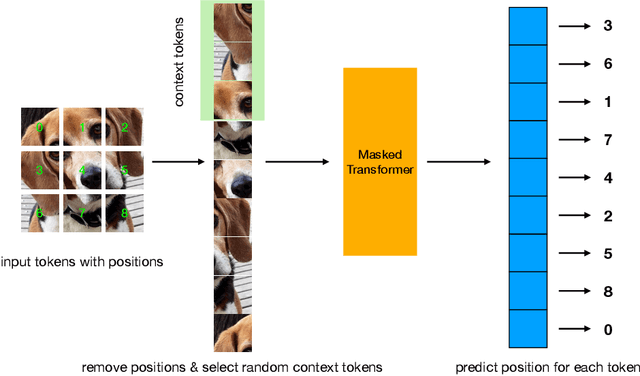

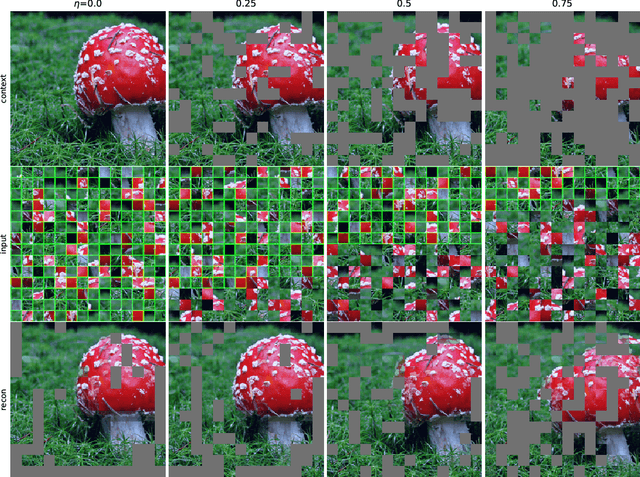

Abstract:Transformers have gained increasing popularity in a wide range of applications, including Natural Language Processing (NLP), Computer Vision and Speech Recognition, because of their powerful representational capacity. However, harnessing this representational capacity effectively requires a large amount of data, strong regularization, or both, to mitigate overfitting. Recently, the power of the Transformer has been unlocked by self-supervised pretraining strategies based on masked autoencoders which rely on reconstructing masked inputs, directly, or contrastively from unmasked content. This pretraining strategy which has been used in BERT models in NLP, Wav2Vec models in Speech and, recently, in MAE models in Vision, forces the model to learn about relationships between the content in different parts of the input using autoencoding related objectives. In this paper, we propose a novel, but surprisingly simple alternative to content reconstruction~-- that of predicting locations from content, without providing positional information for it. Doing so requires the Transformer to understand the positional relationships between different parts of the input, from their content alone. This amounts to an efficient implementation where the pretext task is a classification problem among all possible positions for each input token. We experiment on both Vision and Speech benchmarks, where our approach brings improvements over strong supervised training baselines and is comparable to modern unsupervised/self-supervised pretraining methods. Our method also enables Transformers trained without position embeddings to outperform ones trained with full position information.
 Add to Chrome
Add to Chrome Add to Firefox
Add to Firefox Add to Edge
Add to Edge